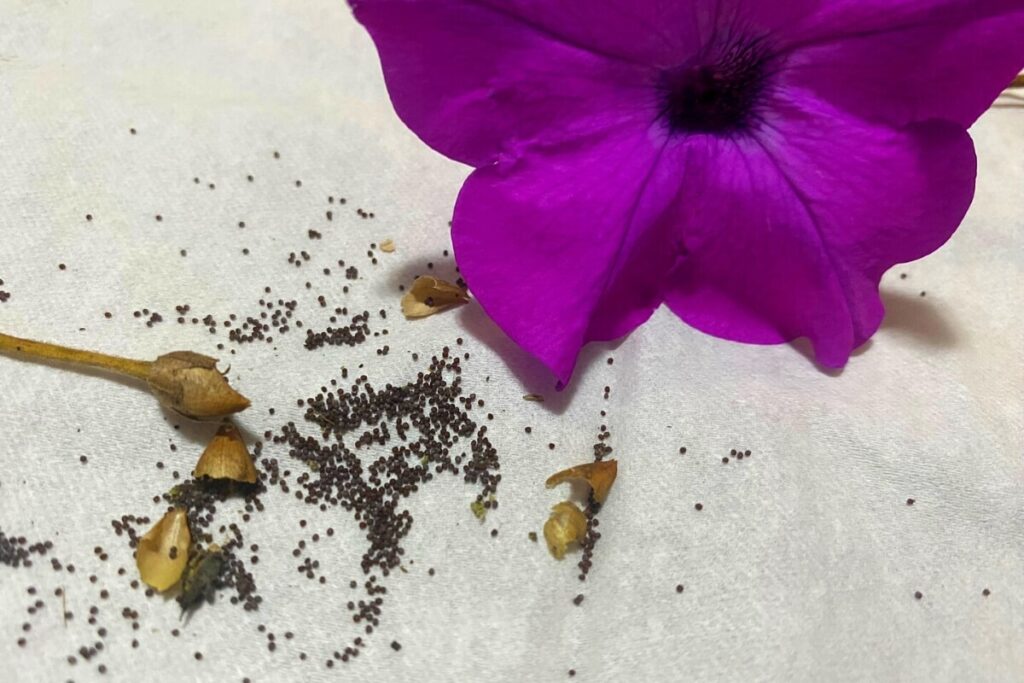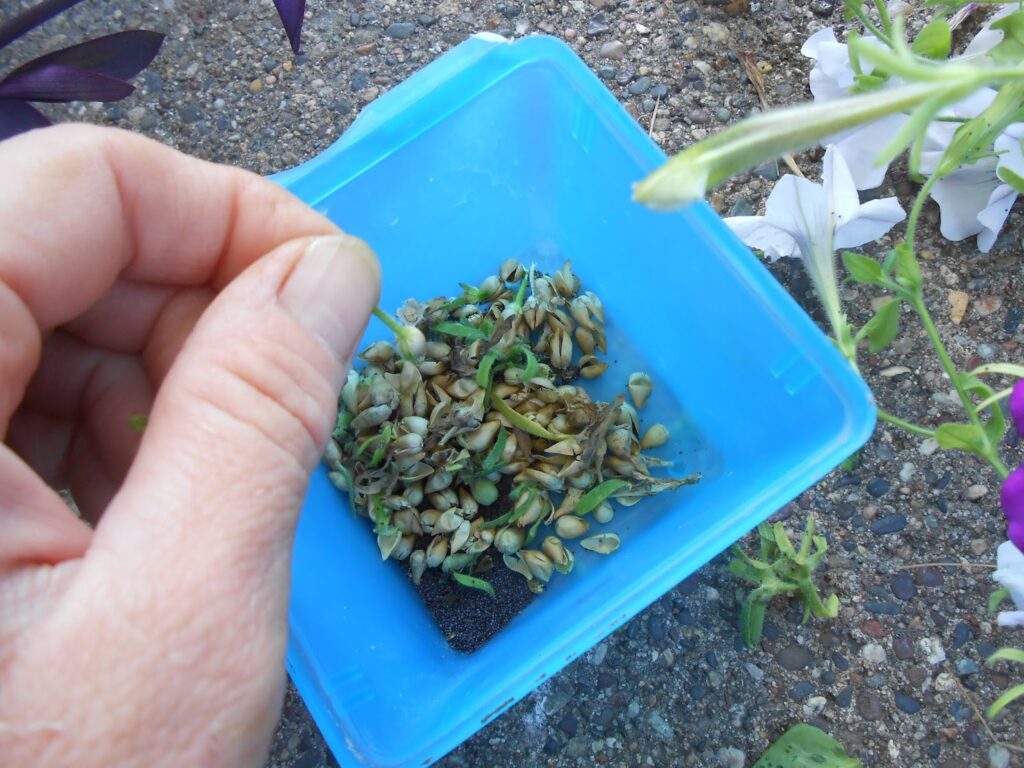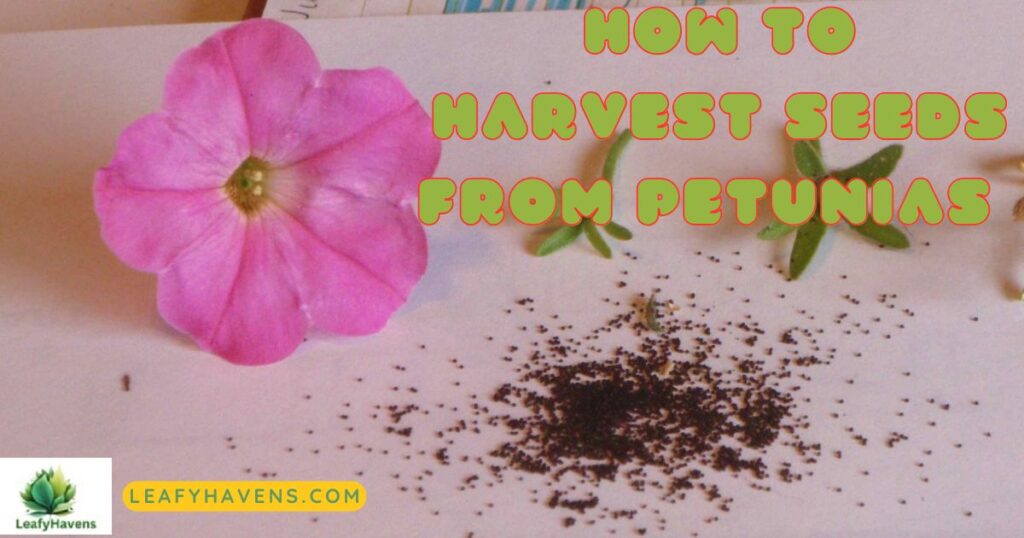Petunias are a favourite in many gardens because of their endurance and bright colours. However, did you know that you can enjoy the beauty of petunias year after year without purchasing new plants by harvesting their seeds? In this article, we’ll guide you through a simple, step-by-step process on how to harvest seeds from petunias and store them effectively.
You may want to read: Are Dahlias Easy to Grow from Seed?
Why Harvest Petunia Seeds?

Harvesting seeds from petunias has numerous advantages:
- Cost savings: You can grow new plants without purchasing seeds.
- Customization: You’ll get seeds from the healthiest and most vibrant blooms.
- Sustainability: Reduce waste by reusing plants from your garden.
Whether you’re a gardening enthusiast or a beginner, collecting petunia seeds is a rewarding activity.
Step-by-Step Guide on How to Harvest Seeds from Petunias

Step 1: Choose Mature Petunia Plants
Select healthy, mature plants that have vibrant blooms and no signs of disease or pests. Avoid hybrid varieties as their seeds may not grow true to the parent plant.
Step 2: Allow Flowers to Wither Naturally
Let the flowers fully bloom and dry out on the plant. Do not cut the flowers prematurely, as immature seed pods may not contain viable seeds.
Step 3: Identify Seed Pods
Look for small, green pods forming at the base of the wilted flower. Over time, these pods will turn brown and dry, indicating they are ready for harvesting.
Step 4: Prepare for Harvesting
Choose a dry day to collect seeds. Have tools like scissors, a clean tray, and paper towels ready to keep the process smooth and clean.
Step 5: Remove Seed Pods
Carefully snip or pluck the dry seed pods from the plant. Handle them gently to avoid scattering the seeds.
Step 6: Open the Seed Pods
Hold the seed pods over a clean surface, like a white sheet of paper or a tray. Gently crush the pods between your fingers to release the seeds.
Step 7: Separate Seeds from Debris
Remove any leftover pod fragments or plant debris. You can gently blow on the seeds to separate them from lightweight debris.
Step 8: Dry the Seeds
Spread the seeds on a clean paper towel or plate. Place them in a warm, well-ventilated area for 2-3 days to ensure they are completely dry.
Step 9: Store the Seeds Properly
Transfer the dried seeds into labeled airtight containers, envelopes, or seed bags. Store them in a cool, dry place away from sunlight and moisture.
Step 10: Plan for Planting
Use your harvested seeds in the next planting season to grow beautiful petunias. Test the seeds by germinating a few to ensure their viability.
How to Store Petunia Seeds
Proper storage ensures your seeds remain viable for the next planting season. Here’s how to do it:
- Label the seeds: Write the variety and date on a small envelope or bag.
- Use airtight containers: Seal the seeds in a container to prevent moisture.
- Store in a cool, dry place: A refrigerator or a dedicated seed box is ideal.
- Avoid direct sunlight and extreme humidity.
By following these steps, you’ll extend the shelf life of your seeds and improve their germination success.
Tips for Successful Seed Harvesting and Storage

1. Harvest on a Dry Day
Collect seeds on a sunny, dry day to avoid moisture, which can cause mold or rot.
2. Choose Healthy Plants
Always select seeds from the healthiest and most vibrant petunias in your garden. This ensures robust future plants.
3. Handle Seed Pods Gently
Seed pods are fragile and can scatter seeds if handled roughly. Use care when removing and opening them.
4. Use Clean Tools
Prevent contamination by using clean scissors, trays, and containers during the harvesting process.
5. Ensure Seeds Are Completely Dry
Moist seeds are prone to fungal growth. Dry them thoroughly for 2-3 days in a warm, ventilated space before storing.
6. Label Your Seeds
Clearly label the seed containers with the variety name and date of harvest. This helps you track their age and type.
7. Store in Airtight Containers
Use airtight jars, seed bags, or envelopes to keep seeds safe from moisture and pests.
8. Keep Seeds in a Cool, Dark Place
Temperature fluctuations and sunlight can reduce seed viability. Store them in a cool, dry environment, like a refrigerator or seed storage box.
9. Check for Moisture Periodically
Inspect stored seeds occasionally to ensure they remain dry. Add silica gel packs to absorb moisture if needed.
10. Test Seed Viability Before Planting
Before planting, test a small batch of seeds by germinating them in a damp paper towel. This helps confirm their viability.
Encouragement to Try Seed Harvesting
Harvesting petunia seeds isn’t just practical; it’s a fun and educational experience. By learning how to harvest petunia seeds, you can create a self-sustaining garden while connecting more deeply with nature. Imagine the joy of seeing your harvested seeds grow into beautiful blooms!
Consider investing in high-quality tools and seed storage supplies to increase the success of your gardening endeavours. When it comes to making sure your plants flourish, reliable gardening materials can make all the difference.
Bottom Line
Mastering the art of how to harvest seeds from petunias is an easy and rewarding way to enjoy these beautiful blooms year after year. You may save money and embrace sustainability while ensuring a successful garden by using the right harvesting, drying, and storage methods. Now is the time to begin gathering petunia seeds from your yard in preparation for a bright and colourful future!
🌸
FAQs About How to Harvest Seeds from Petunias
1. Can I harvest seeds from all types of petunias?
Not all petunias produce reliable seeds. Focus on heirloom and open-pollinated varieties rather than hybrids.
2. How long can I store petunia seeds?
With proper storage, petunia seeds can remain viable for 2-3 years.
3. What is the best time to harvest petunia seeds?
Wait until the seed pods turn brown and dry, typically a few weeks after the bloom fades.
4. Can I plant petunia seeds directly after harvesting?
Yes, but it’s better to dry and store them first for consistent germination.
5. What tools do I need for harvesting petunia seeds?
You’ll need clean scissors, a tray or paper, and an airtight container for storage.





